What is PAT Programming?
PATS is an acronym that stands for Passive Anti-Theft System (Ford also calls this SecuriLock). It is also called a transponder key. It is a security feature found on most (if not all) new Ford products, and what it does is disable your vehicle’s starter unless your specially programmed key is used to start the vehicle. There is a computer chip inside of the key, and without that you will NOT be able to start the vehicle — even if you have a regular (non-PATS) key with the correct cuts, it will not work. When replacing the Powertrain Control Module (PCM) on a PATS-equipped vehicle, a parameter reset or relearn procedure must be performed after the PCM is installed. Vehicles with PATS will not start until this on-car procedure is successfully performed.
This ProTech helps identified what type of PATS your vehicle may have and what steps and
equipment are needed to perform the procedures.
Before attempting a PATS relearn, the replacement PCM must be calibrated to current
vehicle specification, the Flash2 All-Makes Reprogrammer can be used for this purpose.
In addition to flashing, Vehicle Identification Block programming may be required for
some applications.
DISCLAMER
Use manual PATS procedures at your own risk. EASE Diagnostics is not responsible for damage caused by the use of these procedures. These procedures may not work for all mentioned vehicles. Do not contact EASE Diagnostics for assistance in the use ofthese procedures. If you are unable to perform the manual PATS procedures use the Ford Module Programmer application.
This PAT programming apply to below models:
Ford Contour ‘98–up
F-150 ‘98-up
Ford Crown Victoria ’97-up
Ford Escort 99-up
Ford Excursion ‘00-up
Ford Expedition ‘98–up
Ford Explorer ’98-up
Ford Focus ‘00-up
Ford Mustang ’96-up
Ford Ranger ’98-up
Ford Taurus ’96-up
Ford Windstar ’98-up
Lincoln Continental’98-up
Lincoln LS ’00-up
Lincoln Mark VIII ’98-up
Lincoln Navigator ’98-up
Lincoln Town Car ’98-up
Mercury Grand Marquis ’97-up
Mercury Mountaineer ’98-up
Mercury Mystique ’98-up
Mercury Sable ’96-up
NOTE: These instructions may apply to more or less vehicles than those listed above. Ease cannot confirm that these procedures work for every year and model listed.
ON-BOARD PROGRAMMING METHOD “B”
for Ford keys (1996 -early 1998 Ford, Lincoln, Mercury)
If you want to initiate a new master key….
1.Insert new key into ignition cylinder and turn it to the ON (RUN) position. The security light on the dash will flash for fifteen minutes.
2.When the security light stops flashing, you have FIVE minutes to start the next step. Turn the ignition cylinder OFF and then back to the ON (RUN) position. The security light on the dash will flash for fifteen more minutes.
3.When the security light stops flashing, you have FIVE minutes to start the next step. Turn the ignition cylinder to OFF and then back ON (RUN) position. The dash will flash for fifteen more minutes.
4.After the security light stops flashing the third time, the new key has been programmed into the vehicles computer and will operate the car. It has replaced ALL the previous electronic key codes and is the ONLY key programmed into the vehicles computer.
If you want to add a key….
1.Insert an existing key into the ignition cylinder.
2.Turn the ignition cylinder to ON(RUN) and back to OFF.
3.Remove the existing key and, within 15 seconds,insert the new key and turn it to ON(RUN).
4.The security light will light up for two seconds to indicate success in programming the key into the vehicle.
5.Don’t attempt to start the vehicle with any key for at least 1 minute.
ON-BOARD PROGRAMMING METHOD “C”
for Ford keys (Later 1998-newer Ford, Lincoln, Mercury)
If you want to initiate a new master key….
- In order to initiate a new master key, this will require the use of the Ford Module Programming Application.
There are two ten minute delays involved while this device erases all existing key programming and sets up the vehicle computer to accept new key codes. Two new keys should be ready because the system requires a minimum of two keys in the program. After the first two keys are programmed, additional keys can be entered individually by following the instructions for adding duplicate keys (below).
If you want to add a key….
**You must have two original keys to perform this procedure.
1.Insert an existing (working) key into the ignition cylinder.
2.Turn the ignition cylinder ON (RUN) and back to OFF. Ignition should stay on for at least ONE SECOND.
3.Remove the existing key and, within TEN seconds, insert a second working key and turn it to ON (RUN) and the back OFF.Ignition must be in ON for at least ONE second, but no more than TEN seconds. Remove the key.
4.Insert the new key before TWENTY seconds have elapsed and turn it to ON (RUN). Leave it the
ON position for at least ONE second and turn back to OFF.
5.The security light will light up for THREE seconds to indicate that the new key has been successfully programmed.
6.To program additional keys, repeat steps 1 through 5
As a precautionary measure for all of the above procedures, you should wait at least one minute after you have performed this until you start your vehicle.
Guide 2:Program PATS using FORScan (original from forscan.org)
This article describes PATS programming procedure. The article is actual for version 2.3.8 (PATS programming is implemented for Ford, Mazda, Lincoln and Mercury models approximately of 1997-2011 model year, depends on model and market). If PATS programming functions is not available in the list of service functions, it means it is not implemented for this model. If the PATS programming function is available in the Service chapter, it is implemented for this model and must work in full.
There are 2 types of secure access: coded and timed. Coded requires an incode generation by the outcode provided by vehicle. Timed access requires that operator has wait for some period of time (usually 10 minutes) with diagnostic tester connected. Some vehicles support only coded access, some only timed access, some support both. FORScan supports all of these options. If both access types are available, FORScan asks user to select the preferred one. Coded access can be done fast, but requires incode/outcode calculator. Timed access doesn’t require any code exchange, but requires signfificant timeframe (at least 10 mins). Module Initialization option (available for some models) may require special Dual coded access. Detailed information about
Module Initialization function:
PATS programming menu in FORScan has several functions, for some models the Module Initialization option is available. This is quite important option so we have decided to create a dedicated article to discuss it.
In many cases PATS system is distributed, it means more than one module is involved in the protection. Module Initialization function is designed to synchronize (match) these modules with each other. It should not be used during simple key programming (except AU models). The inialization logic is model-specific, so it is always recommended to read information FORScan provides before start of the procedure (same informaion is always available using Help item in the PATS programming menu):
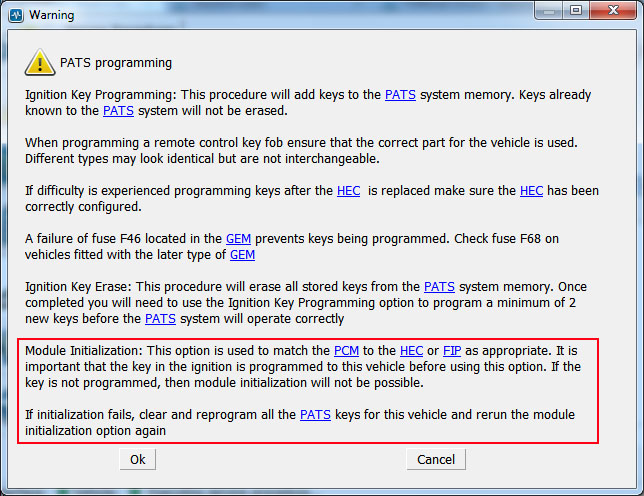
Another specific thing is that in some cases so-called Dual access to PATS may be required instead of Single access. Obtaining outcode/incode is identical with Single access, except that Dual type is displayed by FORScan and have to be specified in Outcode/Incode calculator.
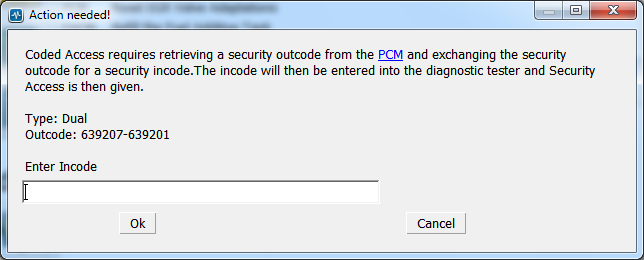
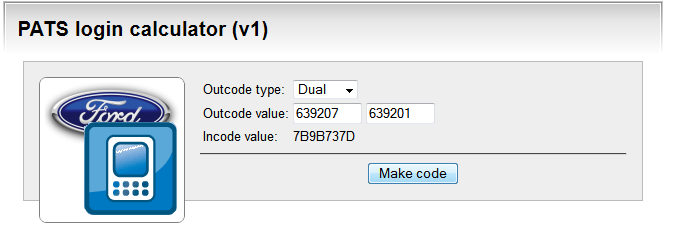
Let’s review most common use cases:
1.Mondeo Mk3/Focus Mk1/Transit with Duratorq DI engines
In these models the Module Initialization function must be used if FIP (high pressure fuel pump) and/or PCM module is replaced. Most common usage – initialize when new fuel pump is installed. Duratorq TDCI engines of the same models have no Module Initialization functions
If PCM module or both FIP + PCM are replaced, the following sequence of actions should be performed:
i. Erase all keys (Single coded or timed access have to be obtained)
ii. Program at least 2 new keys
iii. Do module initalization
If only FIP module is replaced, then steps (i) and (ii) are not necessary and only step (iii) have to be executed.
2.Focus Mk2/CMax
Module initalization function is used here when instrument cluster (HEC or IC) and/or PCM module is replaced.
If HEC/IC or both HEC/IC + PCM are replaced, the following sequence of actions should be performed:
iErase all keys (Single coded or timed access have to be obtained)
iiProgram at least 2 new keys
iiiDo module initalization (Dual coded access may be required)
If only PCM is replaced, the steps (i) and (ii) are not necessary, and only step (iii) have to be executed.
3.Models for US market (1998-2010)
Module initialization logic here depends on the model, so follow FORScan instructions and acknowledge the Help info as mentioned above. Also, timed access to PATS is used for these models in majoirty of cases. Coded access is almost never used, so there is no problem with outcode/incode.
4.Models for AU market (1999-2006)
These models have no dedicated functions for erase and program keys. Programming is performed as a whole – keys are erased, then programmed. Module initialization is a part of this process and called automatically. Module initialization can be called separately to match BEM and PCM, for example if the match was lost for some reason or programming procedure somehow failed before the initialization was completed. Coded access is also not used here, similar to US market models.
So, what do you need in order to program PATS using FORScan:
1.Extended license (viewtopic.php?f=5&t=836)
2.At least one valid ignition key (master key) that is known by PATS, except the case when all keys are erased from the PATS memory
Let’s review a use case for the following scenario: a vehicle supports coded access. PATS knows 2 master keys, but the owner has only 1 of them. The owner wants to erase the lost key from the PATS memory and program new one (for this purpose a blank key is purchased). There is no way to delete a single key, only all known keys can be erased. So the user has to perform the operation in 2 steps: remove all keys known by PATS and program the old key and the new key. Here we go:
– Run the procedure. We see that PATS knows 2 keys:
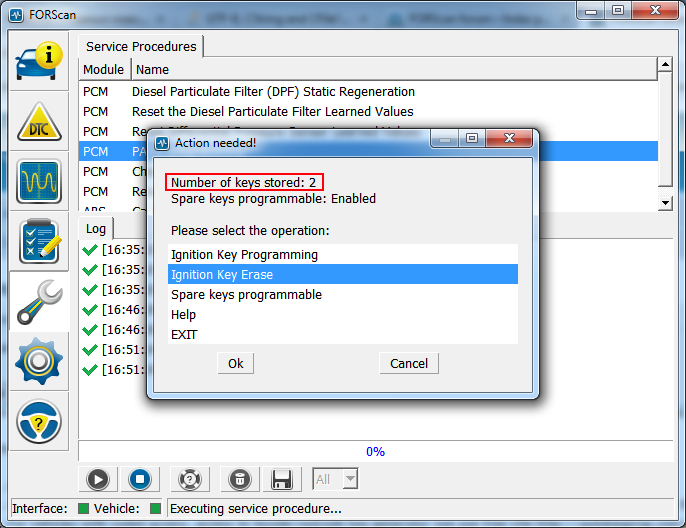
Select the Ignition Keys Erase option. FORScan will read outcode and suggest you to generate an incode using the built-in generator:
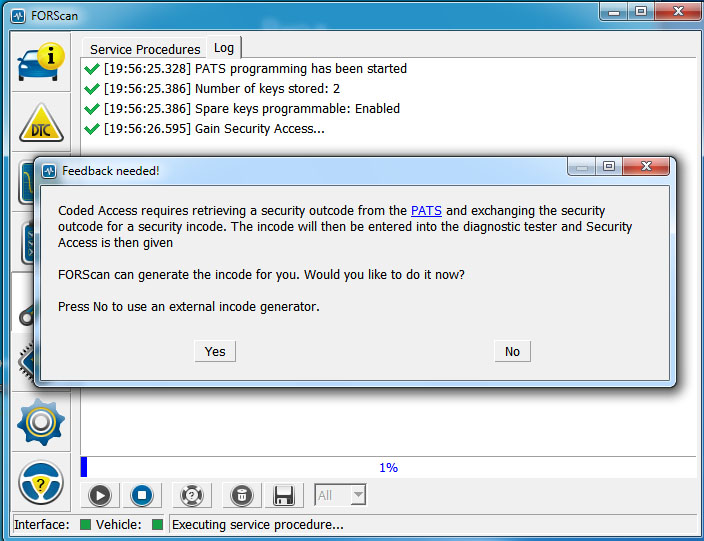
You can accept and generate incode using built-in generator, or refuse and use an external incode generator. In this case FORScan will show you the outcode and ask to enter the incode:
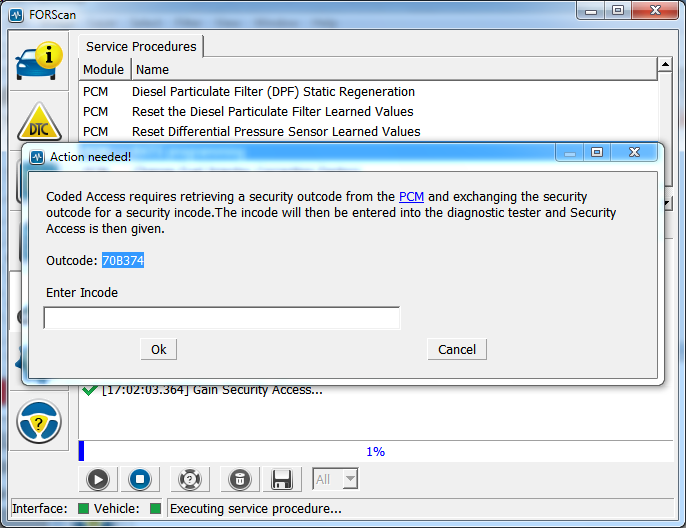
You can use an external service, for example autokeyprog.com to generate the incode:
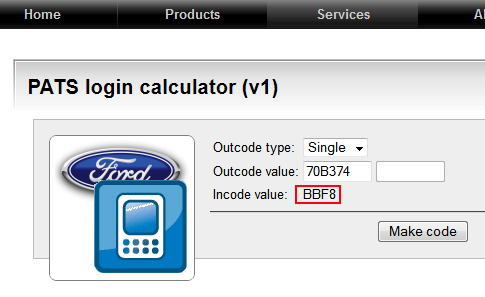
If incode is accepted by PATS and if everything is OK, FORScan will request confirmation on the Erase operation. If confirmed, the operation is executed and user is returned back to the main menu. User should see now zero keys known by PATS.
It is important to do not Exit from the menu, otherwise the security access will be lost, and user will have to obtain the coded/timed access again.
– Now, user should program 2 keys. For this purpose the Ignition Key Programming option must be used. User will be suggested to program the key:
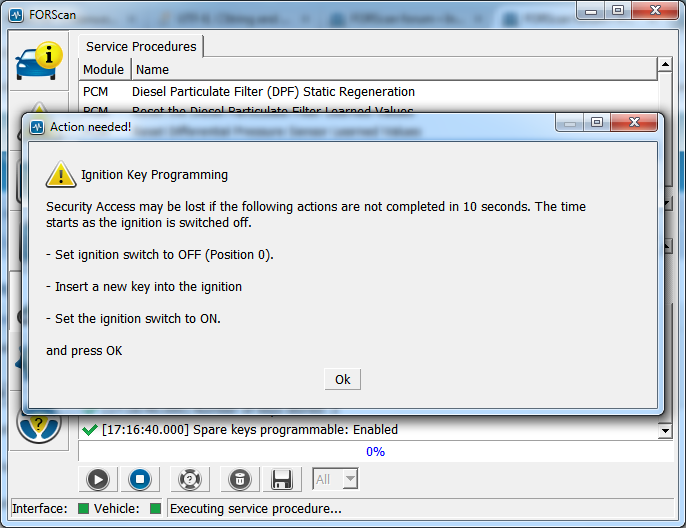
– User should follow the instruction displayed by FORScan, so turn the ignition key to OFF, then back to ON and click OK. FORScan will confirm the operation and ask to turn on/off again.
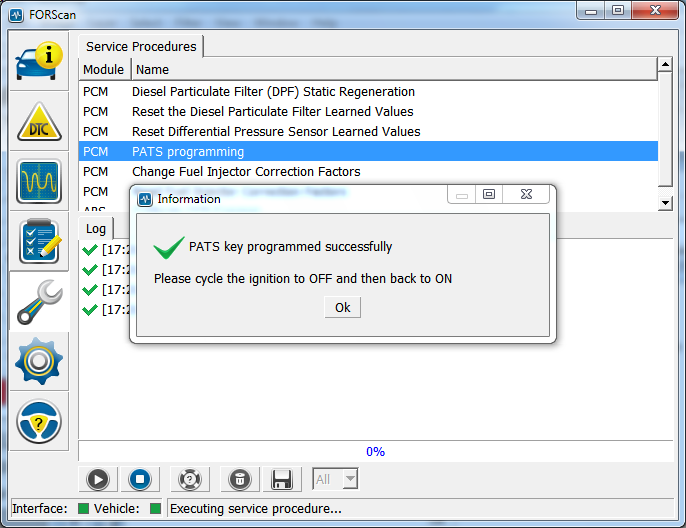
It is important to leave the programmed key in the ignition lock, because number of known keys is non-zero and FORScan will look for a master key.
– program the second key in the same way, except that when FORScan asks to insert new key, the first key has to be removed and the second key has to be inserted.
– When returned back to the main menu, user should see 2 known keys again. But this time these 2 keys are in hands.
Note: some models for Australian and American markets have no stand-alone Ignition Key programming function. The function is available in the PATS menu but PATS doesn’t support it. So on these models it is not possible to add a key to th PATS memory. The only way is to use Erase and Program keys function (added in FORScan v2.2.5). This function erases all keys and switches PATS to a special learning mode. In this mode user can program 2 keys one by one.
WARNING:
Experience shows that 90% of problems with using this function are caused by blank key problems (not-original/china clone, incompatible transponder etc). Consdering this experiene, it must be counted that the Erase function is potentially dangerous, because engine will not start until you program at least 2 keys. So it is STRONGLY RECOMMENDED to check the blank keys (and correct work of the program with your specific vehicle) before executing the Erase function. Just programm it as the 3rd key and if it has been programmed successfully and engine runs using this key, you may execute the Erase function.
Check Blank PATS Key
A lot of complaints to PATS programming function are related to incorrect blank keys used (not working or not compatible transponder). This article describes how to check a blank key using FORScan.
0.Insert the blank key in the ignition lock.
1.Detect the module that contains PATS. It is easy: go to Service tab and look what module contains PATS programming function. Depending on the vehicle, it may be PCM, PATS, IC, HEC etc.
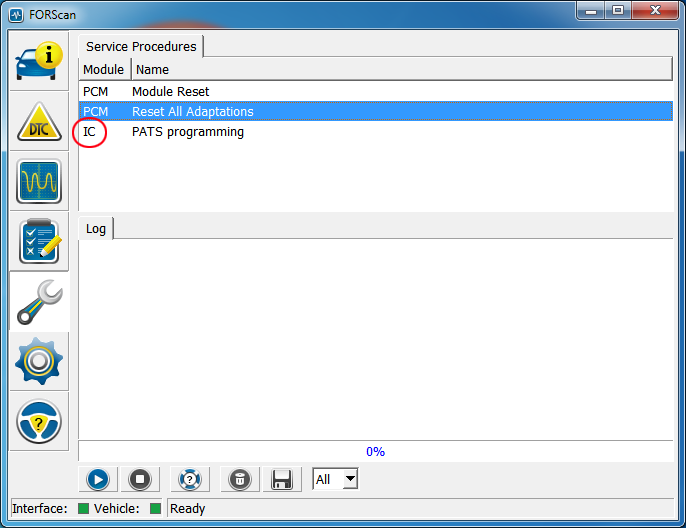
2.Read DTC. For newer vehicles with CAN bus ((Focus Mk2…) it is OK to just read DTC for PATS module in Errors section. For older vehicles (Focus Mk1, Mondeo Mk3…) running the PATS module self-test in Tests section may be necessary
3.Analyze returned DTC codes:
3.1. If the test returns B1601 code (B10D7:51 for new PATS), it means the blank key is OK and can be programmed for this vehicle.
3.2. If the test returns B1600 code(B10D7:87 for new PATS), it means the blank key is not recognized by PATS and can NOT be programmed for this vehicle.
3.3. If the test returns B1602 code (sometimes simulatenously with B1600, B1601) (B10D7:8F for new PATS), it means PATS is unable to stably read the key transponder. That’s possible with clones. You may try to shift the transponder to another place of the key fob. If it doesn’t help, it may be good idea to replace the transponder. Programming such keys in FORScan v2.2.8 and older may look successful (FORScan says key programmed successfully), but in fact the key is not added to the PATS memory (key counter is not increased) and Errors section may display code like B2431 – Transponder Programming Failed.
3.4.If the test returns another code (non of B1601…B1602, but related to PATS), it is recommended to contact support.
3.5. If test executed successfully, but no any of B1600, B1601 codes are returned, it means the key is programmed for this PCM already.
Note 2017-01-03: users’ experience says that B1601 code is not a guarantee of a flawless work. We already have several complaints (all for domestic market cars) when high quality but non-OEM keys produced B1601 code but cannot be programmed. In all cases replacing non-OEM key with OEM one fixed the issue. So please: (i) ask seller for money back warranty in case of non-working key and (II) do not use Erase Keys function until you are sure the new key can be successfully programmed (remember, engine will not start in case of PATS memory has less than 2 learned keys).
Note 2017-10-31: New PATS have other codes:
B10D7:51 instead of B1601 (PATS key is read OK but not added to the PATS memory yet)
B10D7:87 instead of B1600 (blank key is not recognized by PATS)
B10D7:8F instead of B1602 ( PATS is unable to stably read the key transponder)
Guide 3:
Here’s How You Program a PATS Key Yourself
1Start with your two original keys. If you only have one, you can’t program the keys yourself.
2Next, you’ll need a new PATS key that has been cut to match your original keys (you can buy these at your local Ford dealership).
3Start by putting one of your original keys in the ignition.
4Turn the ignition cylinder ON (RUN) for three seconds, then turn it back to OFF.
5Within ten seconds, remove the first original key and insert the second original key, and then turn to ON (RUN) for three seconds, and then back to OFF.
6Within ten more seconds, insert the new key and turn to ON for three seconds, then turn back to OFF.
7If you did it right, the “security” light on the dash will illuminate for three seconds. Congrats!
8Repeat this process for any additional keys.
Disclaimer: Be sure to check your owner’s manual if you have questions. This video is for informational purposes only – use this process at your own risk.
Refer:
The following simplified descriptions explain the PATS procedure required when installing
a replacement PCM. Please refer to the Ford PATS Guide for detailed procedures.
Replacing PCM only — A or D type PATS
If only the PCM is being replaced on a PATS control function type A or D vehicle, no
relearn is required (please refer to the Ford PATS chart to determine PATS type). Simply
put the original key in the ignition, turn to ON or RUN and wait for 20 seconds. Then turn
the key off and start vehicle.
Replacing PCM only — B, C, F or G type PATS
If only the PCM is being replaced on a PATS control function type B, C, F or G vehicle, the
Parameter Reset function must be performed. This requires a scan tool with the Parameter
Reset function, or the J2534 CARDONE Flash2 All-Makes Reprogrammer with Ford license and a subscription to Ford Module Programming (FMP). The FMP program can be purchase from Ford at www.motorcraftservice.com. The tool and software used will give specific instructions to follow. The general steps are listed below.
Cycle a key in ignition to RUN
2Enter Security Access on the PATS control function module. For type B, it will be the PATS module, for type C, the Instrument Cluster, for type F, the PCM, for type G, the Instrument Cluster Module. (This takes 10 minutes).
3Select “Parameter Reset” and exit Security Access.
4Select a PCM Keep Alive Memory (KAM) reset.
5Start vehicle.
Replacing PCM only — E type PATS
If only the PCM is being replaced on a PATS control function type E vehicle, two keys
need to be programmed into the PCM. This requires a scan tool with capability to
program PATS type E keys, or a CARDONE Flash2 All-Makes Reprogrammer with Ford
license and subscription to www.motorcraftservice.com. The tool and software used will
give specific instructions to follow. The general steps are listed below.
1Cycle key 1 to RUN
2Enter Security Access on PATS control function module. (This takes 10 minutes).
3Select “Ignition Key Code Erase”
4Disconnect tool and leave key in RUN position for 20 seconds
5Cycle key 1 to OFF, then RUN, and back to OFF.
6Cycle key 2 to RUN, then OFF.
7Start vehicle.
Identifying the type of security system your application may or may not have, beforereplacing the PCM, will avoid the disappointment of a no-start after the replacement PCM is installed. And, if your vehicle does have PATS security, you will know ahead of time what procedures and equipment may be required to get the vehicle down the road.